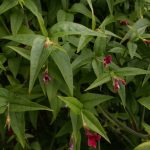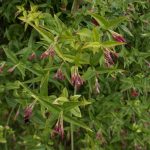A climbing plant with plentiful tubular red flowers, Jasminum beesianum makes the usual mass of tangled growth expected of these plants with loose scandent growth. Some twisting action around supporting structures from the younger shoots is helping to support the tangled growth. Light green foliage and small tubular red flowers are held in the leaf axils. This is one of George Forrest’s many introductions from western China. The parent plant found growing in an open aspect on stony ground at around 2500m; this was in 1906 during the expedition that was ill fated with the loss of all Forrest’s companions. All descriptions of the plant mention fragrant /scented flowers. Despite bringing a few into the warmth only a faint smell emanated and this was not sweet.

Jasminum beesianum

Jasminum beesianum

steve jones
I like the look of this red jasmine, I have white jasmine growing in my garden and I would like to grow the red alongside, does it root as easily as the white? And how long is the flowering season?
Hort
It usually flowers for about a month in early summer and roots easily form cuttings. It is freely available in the trade.
Linda Keogh
Not happy with fragrance.
Linda
Disappointed that is not very fragrant. Could white jasmine be planted with it?
Linda Keogh
Can white jasmine be planted with the red?
Hort
Yes the red one has a poor fragrance, white jasmine could be planted with it though it likes a little more sun to flower well.
Becca
I’m very disappointed with mine – loads of growth but hardly any utterly insignificant flowers and no perfume. I read that it’s ok in shade, and mines in semi shade. Is this the wrong place for it? And should I prune it?
LORI THOMAS
Hi, I was given a red jasmine plant as a gift. The included card indicates it is an indoor plant. (I live in zone 7) How does this plant thrive indoors? Should I move it outside in the summer? Will it lose it’s leaves in the winter? Thanks for your help!
Hort
If you are in the USA, hardiness is down to a maximum of -14.9 °C (5 °F) but it may be cut to ground level by that degree of frost but if mulched should resprout. Alternatively grow it in a large container and move it to a place where it can be ket at freezing or just above. In the UK it is hardy in all but the coldest parts of the UK.